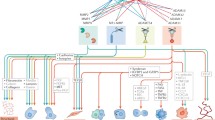Abstract
Matrix metalloproteinases (MMPs) are a family of zinc-dependent endopeptidases, which can synergistically degrade the major components of extracellular matrix (ECM). A key role in maintaining the balance between ECM deposition and degradation in several physio-pathological processes is carried out, through multiple biological functions, by four members of the tissue inhibitors of metalloproteinases (TIMPs) family. TIMP-1 and TIMP-2 are capable of inhibiting the activities of MMPs, can inhibit tumour growth, invasion and metastasis, exhibit growth factor-like activity, can inhibit angiogenesis and suppress programmed cell death (PCD) independently of the MMP-inhibitory activity. TIMP-3 is the only member which is tightly bound to ECM, inhibits TNF-α converting enzyme and induces PCD through the stabilization of TNF-α receptors on the cell surface. TIMP-4 plays a role in ECM homeostasis in a tissue-specific fashion and its overexpression induces PCD. The aim of this article is to review the exciting and intriguing literature on TIMPs, with special emphasis on their conflicting-paradoxical roles in PCD and their potential clinical usefulness.
Similar content being viewed by others
References
Birkedal-Hansen H. Proteolytic remodelling of extracellular matrix. Curr Opin Cell Biol 1995; 7: 728-735.
Nagase H, Woessner JF, Jr. Matrix metalloproteinases. J Biol Chem 1999; 274: 21491-21498.
Murphy G, Willenbrock F. Tissue inhibitors of matrix metalloendopeptidases. Methods Enzymol 1995; 248: 496-510.
Gomez DE, Alonso DF, Yoshiji H, et al. Tissue inhibitors of metalloproteinases: Structure, regulation and biological functions. Eur J Cell Biol 1997; 74: 111-122.
Brew K, Dinakarpandian D, Nagase H. Tissue inhibitors of metalloproteinases: Evolution, structure and function. Biochim Biophys Acta 2000; 1477: 267-283.
Coultas L, Strasser A. The molecular control of DNA damageinduced cell death. Apoptosis 2000; 5: 491-507.
Samoli A, Zhivotovsky B, Jones D, et al. Apoptosis: Cell death defined by caspase proteolytic activation. Cell Death Diff 1999; 6: 495-498.
Cryns V, Yuan J. Proteases to die for. Genes Develop 1998; 12: 1551-1570.
Jones SE, Jomary C, Neal MJ. Expression of TIMP-3 mRNA is elevated in retinas affected by simplex retinitis pigmentosa. FEBS Lett 1994; 352: 171-174.
Ritter LM, Garfield SH, Thorgeirsson UP. Tissue inhibitor of metalloproteinases-1 binds to the cell surface and translocates to the nucleus of human MCF-7 breast carcinoma cells. Biochem Biophys Res Commun 1999; 257: 494-499.
Zhao WO, Li H, Yamashita K, et al. Cell cycle-associated accumulation of tissue inhibitor of metalloproteinases-1 in the nuclei of human gingival fibroblasts. J Cell Sci 1998; 111: 1147-1153.
Boudreau N, Sympson CJ, Werb Z, et al. Suppression of ICE and apoptosis in mammary epithelial cells by extracellular matrix. Science 1995; 267: 891-893.
Bian J, Wang Y, Smith MR, et al. Suppression of in vivo tumor growth and induction of suspension cell death by tissue inhibitor of metalloproteinases TIMP-3. Carcinogenesis 1996; 17: 1805-1811.
Smith MR, Kung H, Durum SK, et al. TIMP-3 induces cell death by stabilizing TNF-alpha receptors on the surface of human colon carcinoma cells. Cytokine 1997; 9: 770-780.
Amour A, Slocombe PM, Webster A, et al. TNF-alpha converting enzyme is inhibited by TIMP-3. FEBS Lett 1998; 435: 39-44.
Baker AH, Zaltsman AB, George SJ, et al. Divergent effects of tissue inhibitor of metalloproteinase-1,-2 or-3 overexpression on rat vascular smooth muscle cell invasion, proliferation, and death in vitro. TIMP-3 promotes apoptosis. J Clin Invest 1998; 101: 1478-1487.
Ahonen M, Baker AH, Kahari VM. Adenovirus-mediated gene delivery of tissue inhibitor of metalloproteinases-3 inhibits invasion and induces apoptis in melanoma cells. Cancer Res 1998; 58: 2310-2315.
Baker AH, George SJ, Zaltsman AB, et al. Inhibition of invasion and induction of apoptotic cell death of cancer cell lines by overexpression of TIMP-3. Br J Cancer 1999; 79: 1347-1355.
Bond M, Murphy G, Bennett MR, et al. Localization of the death domain of tissue inhibitor of metalloproteinase-3 to the N terminus. Metalloproteinase inhibition is associated with proapoptotic activity. J Biol Chem 2000; 275: 41358-41363.
Guedez L, Courtmanch L, Stetler-Stevenson M. Tissue inhibitor of metalloproteinase-1 induces differentiation and an antiapoptotic phenotype in germinal center B cells. Blood 1998; 92: 1342-1349.
Guedez L, Stetler-Stevenson WG, Wolff L, et al. In vitro suppression of programmed cell death of B cells by tissue inhibitor of metalloproteinases1. J Clin Invest 1998; 102: 2002-2010.
Gaudin P, Trocme C, Berthier S, et al. TIMP-1/MMP-9 imbalance in an EBV-immortalized B lymphocyte cellular model: Evidence for TIMP-1 multifunctional properties. Biochim Biophys Acta 2000; 1499: 19-33.
Li G, Fridman R, Kim HR. Tissue inhibitor of metalloproteinase-1 inhibits apoptosis of human breast epithelial cells. Cancer Res 1999; 59: 6267-6275.
Valente P, Fassina G, Melchiori A, et al. TIMP-2 overexpression reduces invasion and angiogenesis and protects B16F10 melanoma cells from apoptosis. Int J Cancer 1998; 75: 246-253.
Lim MS, Guedez L, Stetler-Stevenson WG, et al. Tissue inhibitor of metalloproteinase-2 induces apoptosis in human T lymphocytes. Ann NY Acad Sci 1999; 878: 522-523.
Tummalapalli CM, Heath BJ, Tyagi SC. Tissue inhibitor of metalloproteinase-4 instigates apoptosis in transformed cardiac fibroblasts. J Cell Biochem 2001; 80: 512-521.
Soloway PD, Alexander CM, Werb Z, et al. Targeted mutagenesis of TIMPs reveals that lung tumour invasion is influenced by TIMPs genotype of the tumour but not by that of the host. Oncogene 1996; 13: 2307-2314.
Garbisa S, Sartor L, Biggin S, et al. Tumour gelatinases and invasion inhibited by the green tea flavanol epigallocatechin-3-gallate. Cancer 2001; 91: 822-832.
Mannello F, Gazzanelli G, Luchetti F, et al. Matrix metalloproteinases expression in HL60 promyelocytic leukaemia cells during apoptosis. Apoptosis 2000; 5: 165-172.
Mitsiades N, Poulaki V, Leone A, et al. Fas-mediated apoptosis in Ewing's sarcoma cell lines by metalloproteinase inhibitors. J Natl Cancer Inst 1999; 91: 1678-1684.
Baker AH, Ahonen M, Kahari VM. Potential applications of tissue inhibitors of metalloproteinase overexpression for cancer gene therapy. Adv Exp Med Biol 2000; 465: 469-483.
Author information
Authors and Affiliations
Rights and permissions
About this article
Cite this article
Mannello, F., Gazzanelli, G. Tissue inhibitors of metalloproteinases and programmed cell death: Conundrums, controversies and potential implications. Apoptosis 6, 479–482 (2001). https://doi.org/10.1023/A:1012493808790
Issue Date:
DOI: https://doi.org/10.1023/A:1012493808790




